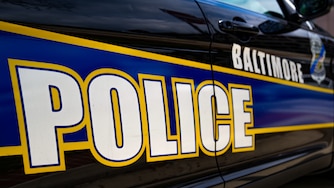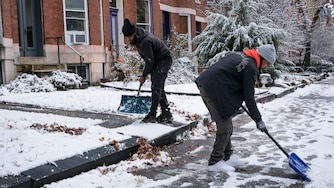In the early hours of Tuesday morning, a massive container ship struck the Key Bridge, causing the structure to collapse in moments. But could it have been prevented?
Engineering experts told The Baltimore Banner that this will be the main question for investigators in the wake of the tragedy and raised similar concerns about what little we know about the 47-year-old bridge and its subsequent collapse so far.
Abi Aghayere, a professor of structural engineering at Drexel University, said his first reaction to seeing footage of the disaster was to wonder whether the bridge was designed to resist the massive force that would be generated by impact from a container ship, even traveling at low speeds.
Given that the four-lane bridge was constructed half a century ago, Aghayere questioned whether the original design took into account that the ships, which have grown considerably in size since then, would be maneuvering so close to the piers.
“If they didn’t design for that, why was there not a protection system like a bumper system around the piers to at least stop any vessel from going straight into hitting the bridge?” Aghayere asked.
He added that U.S. code for bridge construction considers that very possibility, and it’s something engineers always assess when designing bridges, but that it’s unclear when this design was last revisited.
Transportation Secretary Pete Buttigieg said he “didn’t know any bridge built to withstand impact” from a container ship like the Dali.
Aghayere said that if a bridge can’t be designed to do that, it should be reconfigured, such as moving bridge piers into shallower water where ships don’t travel, which might require a longer span.
“It’s one thing to say no bridge could be designed to resist these forces, but if you have vessels moving around there, the likelihood that this is going to happen is high,” he said. “It’s going to happen.”

The bridge collapsed just days after the 47th anniversary of its opening, raising a myriad of questions regarding the state’s continuing and future transportation projects. Maryland officials now face a massive and unexpected need even as a mix of inflation and declining revenues squeezes the state’s transportation budget.
“This is going to be a long-term build. It’s gonna be a build that’s going to require every facet and every aspect of our society,” said Gov. Wes Moore at a news conference Tuesday morning.
Moore stressed Tuesday morning that the current focus was on rescue operations and that he could not speculate on a cost or timeline for replacing the bridge.
President Joe Biden pledged later Tuesday that the federal government would pay the entire cost of rebuilding the bridge.
The Federal Highway Administration requires inspection of all bridges every two years. But the Maryland Transportation Authority, which oversees all state toll facilities, inspects major assets, including the Key Bridge, every year. The agency uses a “data-driven asset management program” to model future deterioration and recommend projects, according to an agency asset report.
Rescue teams are actively searching for multiple missing persons lost in the water during the pre-dawn collapse, including six construction workers who were in the midst of resurfacing the bridge’s roadway.
R. Shankar Nair, a civil engineering expert, said it was too early to form a strong opinion on the root cause of the collapse, but questioned whether the bridge was adequately safeguarded.
”As a matter of principle, when there is a bridge pier in a shipping channel we should expect the bridge to be strong enough to withstand impact or to be protected from impact,” Nair said. “From the result, we know that wasn’t the case here.”
Khalid M. Mosalam, a structural engineer and professor of civil engineering at the University of California, Berkeley, said the Key Bridge was designed as a steel, continuous truss bridge that, by design, “heavily relies on the integrity of its supports.”
In watching video of the collapse frame by frame, Mosalam said, he could clearly see where the ship hits one of the pillars, causing the span on the west to collapse first, followed by the collapse of the main span.
”As dramatic as this seems, it’s not a surprise to me to see a loss of a support of a continuous truss bridge like that lead to its overall collapse,” Mosalam said. He questioned the size of the bridge columns, which to him “didn’t seem big enough to take such an impact.”
”Certainly, if this pillar was bigger than what it was, to take such a massive impact, it would have survived, and that collapse wouldn’t have happened,” Mosalam said. Having said that, he said, the hit from the ship “might have been so excessive that a reasonable increase in the size of the columns still wouldn’t have been able to survive.”
”As unfortunate as it is, we will learn from it,” Mosalam said.

Rachel Sangree, an associate teaching professor in the civil and systems engineering department of the Johns Hopkins University, teaches a bridge design class focused on superstructures. She said the three-span continuous steel truss bridge is “an efficient way to build a bridge,” but the cargo ship struck it at one of the “worst possible locations.”
That means if something happens to one span, it can impact all of them, she said. ”There’s always a cost tradeoff. We can’t make a structure that’s 100% indestructible for environmental reasons and reasons of natural resources, but we do need to make sure that they’re safe.”
The Francis Scott Key Bridge, which opened in 1977 after a five-year, $110 million build and completed the Baltimore Beltway loop, is one of three connectors over the Patapsco River. It handles significantly less traffic than the Interstate 95 Fort McHenry Tunnel and Interstate 895 Harbor Tunnel Thruway — in 2022, about 38,000 vehicles crossed it on the average workday, according to State Highway Administration data.
But the bridge held an outsized importance for freight delivery, handling roughly 1.3 million truck trips per year, said Louis Campion, president and CEO of the Maryland Motor Truck Association. “It’s a vital link to the port. If you break that down daily, it’s more than 3,600 truck trips a day,” Campion said.
Part of that outsized importance is carrying hazardous materials that are not permitted in the I-95 or I-895 tunnels, Campion explained. In the interim, the only alternative for many trucks will be the wide loop around the Baltimore Beltway’s western half.
The main drag of the 1.6 mile-long bridge between Sollers Point and Hawkins Point has a clearance of roughly 185 feet — depending on tides — for container ships to access parts of the Port of Baltimore. Some have asked whether the bridge would eventually need to be raised to account for larger ships that can handle more containers.
Just last month, Moore touted a new Port of Baltimore cargo record. In 2023, the port handled 52.3 million tons of cargo worth roughly $80 billion.
The Maryland Transportation Authority, which largely funds its own maintenance and expansion work through toll revenues, completed a series of Key Bridge capital projects in recent years. In 2020, crews wrapped up a roughly $20 million sweep to rehabilitate substructures and superstructures of 20 bridges spanning I-695 — that included lead-up areas of the Key Bridge facility but not the section struck by the container ship, according to an MDTA spokesperson.
They had planned to replace the concrete bridge deck in the coming years, citing “extensive deterioration” and anticipated increases in truck traffic. State officials were also planning to add a fiberglass jacket protection system at the water pier columns, starting in the winter of 2029. They estimated that the project would take three years to complete.

Ship collisions are rare, but they are not without historical precedent. There have been about 40 recorded events in the past 65 years, said Sherif El-Tawil, the Antoine E. Naaman Collegiate Professor of Civil and Environmental Engineering at the University of Michigan. He pointed to the Sunshine Skyway Bridge collapse in Tampa Bay, Florida, in 1980, which caused 35 deaths and led to the development of ship collision specifications for bridges.
“The ship collision guidelines came into effect in the early 1990s so they were too late in this case,” El-Tawil said in an email.
He noted that the bridge appeared to lack a “protection system,” which could have protected the bridge and the ship from damage in the event of a crash. This could have been created, for example, in the form of an artificial island, a pile embedded to the river’s floor or a fender attached to the pier system.
“I suspect that the cost of a protection system would likely be extremely high and is likely the reason it was not implemented,” he said.
The state of Maryland has more than 5,000 bridges, with more than 2,000 under the purview of the Maryland State Highway Administration. Of those, about 1% are rated “poor,” according to the state, and the number of “poor” bridges has fallen from 143 in 2006 to 26 in 2022.
The Key Bridge does not fall under the jurisdiction of the MSHA; it is maintained by the Maryland Transportation Authority, or MDTA.
In a review of assets by the Maryland Department of Transportation in 2021, it noted that the MDTA performs inspections on its bridges at least once every two years. Of its 326 bridges, 73% were given a “fair” grade, and 27% were listed as “good,” according to the department’s asset management plan.
The Banner has not immediately been able to review bridge inspection records.

After the deadly Interstate 35W bridge collapse in Minneapolis in 2007, then-Maryland Gov. Martin O’Malley’s administration declared all Maryland bridges “safe” and said that maintaining bridge safety ranked first among the state’s funding priorities.
According to a news release at the time, the state reported that major crossings in Maryland such as the Key Bridge and the Chesapeake Bay Bridge were inspected annually. The Federal Highway Administration’s annual audits of the state’s bridge inspection program consistently earned “excellent” scores, according to the state.
Baltimore Banner reporters Brenda Wintrode and Justin Fenton contributed to this report.




Comments
Welcome to The Banner's subscriber-only commenting community. Please review our community guidelines.